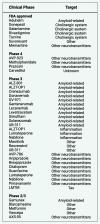The neuroimmune axis of Alzheimer's disease
- PMID: 36703235
- PMCID: PMC9878767
- DOI: 10.1186/s13073-023-01155-w
The neuroimmune axis of Alzheimer's disease
Abstract
Alzheimer's disease (AD) is a genetically complex and heterogeneous disorder with multifaceted neuropathological features, including β-amyloid plaques, neurofibrillary tangles, and neuroinflammation. Over the past decade, emerging evidence has implicated both beneficial and pathological roles for innate immune genes and immune cells, including peripheral immune cells such as T cells, which can infiltrate the brain and either ameliorate or exacerbate AD neuropathogenesis. These findings support a neuroimmune axis of AD, in which the interplay of adaptive and innate immune systems inside and outside the brain critically impacts the etiology and pathogenesis of AD. In this review, we discuss the complexities of AD neuropathology at the levels of genetics and cellular physiology, highlighting immune signaling pathways and genes associated with AD risk and interactions among both innate and adaptive immune cells in the AD brain. We emphasize the role of peripheral immune cells in AD and the mechanisms by which immune cells, such as T cells and monocytes, influence AD neuropathology, including microglial clearance of amyloid-β peptide, the key component of β-amyloid plaque cores, pro-inflammatory and cytotoxic activity of microglia, astrogliosis, and their interactions with the brain vasculature. Finally, we review the challenges and outlook for establishing immune-based therapies for treating and preventing AD.
Keywords: Alzheimer’s disease; Heterogeneity; Immune system; Neuroimmune; β-amyloid.
© 2023. The Author(s).
Conflict of interest statement
The authors declare that they have no competing interests.
Figures


References
-
- Veitch DP, Weiner MW, Aisen PS, Beckett LA, Cairns NJ, Green RC, et al. Understanding disease progression and improving Alzheimer’s disease clinical trials: recent highlights from the Alzheimer’s Disease Neuroimaging Initiative. Alzheimer’s Dementia. 2018;15:106–152. doi: 10.1016/j.jalz.2018.08.005. - DOI - PubMed
Publication types
MeSH terms
Substances
LinkOut - more resources
Full Text Sources
Medical
Miscellaneous

